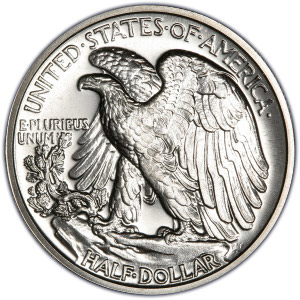The name Adolph Weinman is very well known to every numismatic collector.
 Bullion.Directory precious metals guest post 02 August, 2021
Bullion.Directory precious metals guest post 02 August, 2021
By Nick Adamo
President at Bullion Shark LLC
The coins he designed for the U.S. Mint in the early 20th century — the Mercury dime and Walking Liberty half dollar — are so popular that they have been reproduced on several modern coins over the years.
In fact, Weinman is either the second most influential coin designer in our history after Augustus Saint-Gaudens, whom he knew well and worked with for years, or is tied with him given the large number of coins with his design that have been minted.
Millions of silver coins with his design circulated in the 20th century and later appeared on millions more bullion and collector silver, gold and palladium coins from 1986 to the present.
His design for the obverse of the Walking Liberty half dollar was reprised for obverse of the American Silver Eagle 35 years ago and now appears in a new version that more closely resembles the original design.
 His design for the obverse of the Mercury, or Winged Liberty dime, was reprised in 2017 for the American Palladium Eagle, whose obverse features a design he created for the reverse of a gold medal for the American Institute of Architects.
His design for the obverse of the Mercury, or Winged Liberty dime, was reprised in 2017 for the American Palladium Eagle, whose obverse features a design he created for the reverse of a gold medal for the American Institute of Architects.
And both designs were issued on gold in 2016 to mark the centennial of their debut in 1916.
But Weinman considered himself an architectural and monumental sculptor first and then a coin and medal designer. That is because he did extensive work as a sculptor that is displayed around the country at state capitol buildings in Louisiana, Missouri and Wisconsin to a large statue of Lincoln in Kentucky and other works at the Jefferson Memorial, U.S. Supreme Court and National Zoo in Washington, DC.
He came to New York at 10 after his father passed away and arrived with his mother and brother from Germany where he was born in 1870.
He an early aptitude for art and later studied at famous art centers like the Cooper Union and was soon doing apprenticeships with established artists such Daniel Chester French, who created the huge statue of President Lincoln at the Lincoln Memorial in Washington and who had connections with the U.S. Mint.
By 1895 he was doing that for Saint-Gaudens and would later be asked to prepare the models for the latter’s legendary gold double eagle because St. Gaudens was dying.
He was also asked to work with St. Gaudens to prepare Theodore Roosevelt’s inaugural medal in 1905. His first major commission was to prepare a medal for the Louisiana Exposition in 1904.
Weinman also served on the Commission on Fine Arts where he helped oversee which coin designs are selected for U.S. coins and medals. That experience and his work for President Roosevelt helped propel him towards working for the U.S. Mint designing coins.
Dime and Half Dollar Designs
In 1916 with the influential New York Numismatic Club calling for new designs for our silver coins to replace those of Chief Engraver Charles Barber, the Commission on Fine Arts invited Weinman and two other artists to submit designs for new dimes, quarters and half dollars. His creations that featured designs that appealed to American patriotism and optimism were selected for the dime and quarter, while Hermon MacNeil’s Standing Liberty quarter was selected for the quarter.
Weinman’s design of a Winged Liberty for the dime includes an obverse image of a young woman wearing a Phrygian cap worn by freed slaves in ancient Rome with wings added to symbolize liberty of thought and a reverse with a bundle of rods with an axel blade known as fasces symbolizing justice and set off by olive branches.
His Walking Liberty design showed on its obverse a full-length figure of Liberty striding forward toward the dawn of a new day, enveloped in folds of the American flag with her right hand extended and branches of laurel and oak in her left, which symbolized civil and military glory. The reverse features a stylized eagle perched on a rock ready to take flight clutching pine branch in its talons – an image designed.
The Liberty motifs of both designs are believed to have been inspired by a young woman named Elsie Kachel Stevens whom Weinman had depicted in a bust three years earlier. Elsie and her husband were tenants in a New York building the artist owned. While both designs do feature expressions and facial features reminiscent of Stevens, some experts such as Cornelius Vermeule point out that similar Liberty images predate those designs that were obviously not based on her.
It is always difficult for those studying the designs of artists to determine precisely why they used specific motifs and what impact various models they worked with had on their work, but an interesting new article by Steve Roach in the August 2021 issue of The Numismatist suggests that Weinman’s addition of wings to Liberty may have been related to the women’s suffrage movement of the time that led to the 19th amendment in 1920. He references a poster of the time that supported votes for women and showed a female figure with wings.
In addition, some have argued that Weinman’s Liberty designs, especially the one for the half dollar, appear to be inspired by the famous design by French sculptor Louis Oscar Roty of a French farm girl sowing seeds known as the Sower, but Weinman’s son Robert has said it is impossible to say if it that is the case and that the design is “quintessentially American”.
These iconic designs that were intended to help rally the nation during a period when there were increasing calls for the country to join the war effort in Europe reflect the neoclassic style of art typical of the era when Weinman worked.
But they also are timeless and still resonate with Americans today, which helps explain why generations of collectors continue to admire them so much and build collections of coins with them whether the classic Mercury dime and Walking Liberty or modern silver eagles and American Palladium Eagles. Weinman passed away in 1952 but his sculptures and medallic designs will forever remain part of our culture and heritage.
Nick Adamo


Nick Adamo is President of Bullion Shark, LLC, one of America’s leading Numismatic and Collectibles bullion dealers.
A law graduate and specialist in international business, Nick has helped grow Bullion Shark from it’s small family business roots into a multi-million dollar nationwide numismatics company. Known not just for their vast inventory of collectible and rare coins, Nick and his team specialize in finding clients the un-findable and the impossible.
This article was originally published here
Bullion.Directory or anyone involved with Bullion.Directory will not accept any liability for loss or damage as a result of reliance on the information including data, quotes, charts and buy/sell signals contained within this website. Please be fully informed regarding the risks and costs associated with trading in precious metals. Bullion.Directory advises you to always consult with a qualified and registered specialist advisor before investing in precious metals.












Leave a Reply